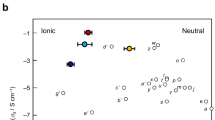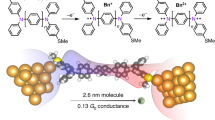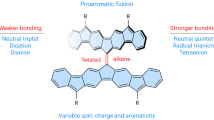Abstract
Hopping and superexchange are generally considered to be alternative electron-transfer mechanisms in molecular systems. In this work we used mixed-valence radical cations as model systems for the investigation of electron-transfer pathways. We show that substituents attached to a conjugated bridge connecting two triarylamine redox centres have a marked influence on the near-infrared absorption spectra of the corresponding cations. Spectral analysis, followed by evaluation of the electron-transfer parameters using the Generalized Mulliken–Hush theory and simulation of the potential energy surfaces, indicate that hopping and superexchange are not alternatives, but are both present in the radical cation with a dimethoxybenzene bridge. We found that the type of electron-transfer mechanism depends on the bridge-reorganization energy as well as on the bridge-state energy. Because superexchange and hopping follow different distance laws, our findings have implications for the design of new molecular and polymeric electron-transfer materials.
This is a preview of subscription content, access via your institution
Access options
Subscribe to this journal
Receive 12 print issues and online access
$259.00 per year
only $21.58 per issue
Buy this article
- Purchase on Springer Link
- Instant access to full article PDF
Prices may be subject to local taxes which are calculated during checkout




Similar content being viewed by others
References
Segal, D., Nitzan, A., Davis, W.B., Wasielewski, M.R. & Ratner, M.A. Electron transfer rates in bridged molecular systems 2. A steady-state analysis of coherent tunneling and thermal transitions. J. Phys. Chem. B 104, 3817–3829 (2000).
Paddon-Row, M.N. in Electron Transfer in Chemistry (ed. Balzani, V.) 179–271 (Wiley-VCH, Weinheim, 2001).
De Cola, L. & Belser, P. in Electron Transfer in Chemistry (ed. Balzani, V.) 97–136 (Wiley-VCH, Weinheim, 2001).
Kilså, K., Kajanus, J., Macpherson, A.N., Mårtensson, J. & Albinsson, B. Bridge-dependent electron transfer in porphyrin-based donor-bridge-acceptor systems. J. Am. Chem. Soc. 123, 3069–3080 (2001).
Launay, J.-P. Long-distance intervalence electron transfer. Chem. Soc. Rev. 30, 386–397 (2001).
Newton, M.D. Quantum chemical probes of electron-transfer kinetics: The nature of donor-acceptor interactions. Chem. Rev. 91, 767–792 (1991).
Nelsen, S.F., Ismagilov, R.F. & Powell, D.R. Effects of bridge redox state levels on the electron transfer and optical properties of intervalence compounds with hydrazine charge-bearing units. J. Am. Chem. Soc. 120, 1924–1925 (1998).
Davis, W.B., Svec, W.A., Ratner, M.A. & Wasielewski, M.R. Molecular-wire behaviour in p-phenylenevinylene oligomers. Nature 396, 60–63 (1998).
Weiss, D.S., Cowdery, J.R. & Young, R.H. in Electron Transfer in Chemistry (ed. Balzani, V.) 379–471 (Wiley-VCH, Weinheim, 2001).
Bässler, H. in Semiconducting Polymers (eds. Hadziioannou, G. & van Hutten, P.F.) 365–410 (Wiley-VCH, Weinheim, 2000).
Herz, T., Gedeck, P. & Clark, T. Fast long-range adiabatic electron transfer in a model polyglycine α-helix. J. Am. Chem. Soc. 121, 1379–1380 (1999).
Tollin, G. in Electron Transfer in Chemistry (ed. Balzani, V.) 202–231 (Wiley-VCH, Weinheim, 2001).
Lewis, F.D. in Electron Transfer in Chemistry (ed. Balzani, V.) 105–175 (Wiley-VCH, Weinheim, 2001).
Giese, B. Long-distance charge transport in DNA: The hopping mechanism. Acc. Chem. Res. 33, 631–636 (2000).
Lambert, C. & Nöll, G. One- and two-dimensional electron transfer processes in triarylamines with multiple redox centres. Angew. Chem. Int. Ed. 37, 2107–2110 (1998).
Lambert, C. & Nöll, G. The class II/III transition in triarylamine redox systems. J. Am. Chem. Soc. 121, 8434–8442 (1999).
Nelsen, S.F., Ismagilov, R.F. & Trieber, D.A. Adiabatic electron transfer: comparison of modified theory with experiment. Science 278, 846–849 (1997).
Schmidt, W. & Steckhan, E. Organic electron transport systems. I. Electrochemical and spectroscopic study of bromo-substituted triarylamine redox systems. Chem. Ber. 113, 577–585 (1980).
Dapperheld, S., Steckhan, E., Brinkhaus, K.-H.G. & Esch, T. Substituted triarylamine cation-radical redox systems - synthesis, electrochemical and spectroscopic properties, Hammet behavior, and suitability as redox catalysts. Chem. Ber. 124, 2557–2567 (1991).
Neugebauer, F.A., Bamberger, S. & Groh, W.R. Mono-, di-, and triarylamine radical cations. Chem. Ber. 108, 2406–2415 (1975).
Le Stang, S., Paul, F. & Lapinte, C. Molecular wires: synthesis and properties of the new mixed-valence complex [Cp*(dppe)Fe-CC-X-CC-Fe(dppe)Cp*][PF6] (X = 2,5 -C4H2S) and comparison of its properties with those of the related all-carbon-bridged complex (X = -C4-). Organometallics 19, 1035–1043 (2000).
Lindeman, S.V., Rosokha, S.V., Sun, D. & Kochi, J.K. X-ray structure analysis and the intervalent electron transfer in organic mixed-valence crystals with bridged aromatic cation radicals. J. Am. Chem. Soc. 124, 843–855 (2002).
Hush, N.S. Distance dependence of electron transfer rates. Coord. Chem. Rev. 64, 135–157 (1985).
Root, L.J. & Ondrechen, M.J. Adiabatic potentials for a bridged three-site electron-transfer system. Chem. Phys. Lett. 93, 421–424 (1982).
Ko, J. & Ondrechen, M.J. Line shape of the intervalence transfer band in bridged mixed-valence dimers: The delocalized case. J. Am. Chem. Soc. 107, 6161–6167 (1985).
Borshch, S.A., Kotov, I.N. & Bersuker, I.B. Electron delocalization in trinuclear mixed-valence clusters. Chem. Phys. Lett. 89, 381–384 (1982).
Brunschwig, B.S., Creutz, C. & Sutin, N. Optical transitions of symmetrical mixed-valence systems in the class II–III transition regime. Chem. Soc. Rev. 31, 168–184 (2002).
Newton, M.D. Control of electron transfer kinetics: Models for medium reorganization and donor-acceptor coupling. Adv. Chem. Phys. 106, 303–375 (1999).
Creutz, C., Newton, M.D. & Sutin, N. Metal-ligand and metal-metal coupling elements. J. Photochem. Photobiol. A 82, 47–59 (1994).
Cave, R.J. & Newton, M.D. Generalization of the Mulliken-Hush treatment for the calculation of electron transfer matrix elements. Chem. Phys. Lett. 249, 15–19 (1996).
Fernández, E., Blancafort, L., Olivucci, M. & Robb, M.A. Intramolecular electron transfer: Independent (ground state) adiabatic (chemical) and nonadiabatic reaction pathways in bis(hydrazine) radical cations. J. Am. Chem. Soc. 122, 7528–7533 (2000).
Nelsen, S.F., Ismagilov, R.F. & Powell, D.R. Charge-localized p-phenylenedihydrazine radical cations: ESR and optical studies of intramolecular electron transfer rates. J. Am. Chem. Soc. 119, 10213–10222 (1997).
Nelsen, S.F., Trieber, D.A., Ismagilov, R.F. & Teki, Y. Solvent effects on charge transfer bands of nitrogen-centered intervalence compounds. J. Am. Chem. Soc. 123, 5684–5694 (2001).
Pfennig, B.W., Fritchman, V.A. & Hayman, K.A. Synthesis, characterization, and photophysical properties of a series of supramolecular mixed-valence compounds. Inorg. Chem. 40, 255–263 (2001).
Rathore, R., Lindeman, S.V., Kumar, A.S. & Kochi, J.K. Disproportionation and structural changes of tetraarylethylene donors upon successive oxidation to cation radicals and to dications. J. Am. Chem. Soc. 120, 6931–6939 (1998).
Nelsen, S.F. & Newton, M.D. Estimation of electron transfer distances from AM1 calculations. J. Phys. Chem. A 104, 10023–10031 (2000).
Acknowledgements
This work was supported by the Fonds der Chemischen Industrie and the Deutsche Forschungsgemeinschaft. We thank JASCO GmbH Deutschland for their support.
Author information
Authors and Affiliations
Corresponding author
Ethics declarations
Competing interests
The authors declare no competing financial interests.
Supplementary information
Supplementary Information
Synthesis and Electrochemistry (PDF 240 kb)
Rights and permissions
About this article
Cite this article
Lambert, C., Nöll, G. & Schelter, J. Bridge-mediated hopping or superexchange electron-transfer processes in bis(triarylamine) systems. Nature Mater 1, 69–73 (2002). https://doi.org/10.1038/nmat706
Received:
Accepted:
Published:
Issue Date:
DOI: https://doi.org/10.1038/nmat706
This article is cited by
-
Radical organometallic nanocages with redox switchable poly-NHC ligands
Nano Research (2023)
-
Effects of donor position on dibenzofulvene-based organic dyes for photovoltaics
Journal of Materials Science: Materials in Electronics (2017)
-
Elaborately Tuning Intramolecular Electron Transfer Through Varying Oligoacene Linkers in the Bis(diarylamino) Systems
Scientific Reports (2016)
-
Kinetic pathway for interfacial electron transfer from a semiconductor to a molecule
Nature Chemistry (2016)
-
Long-Range Ruthenium-Amine Electronic Communication through the para-Oligophenylene Wire
Scientific Reports (2015)



